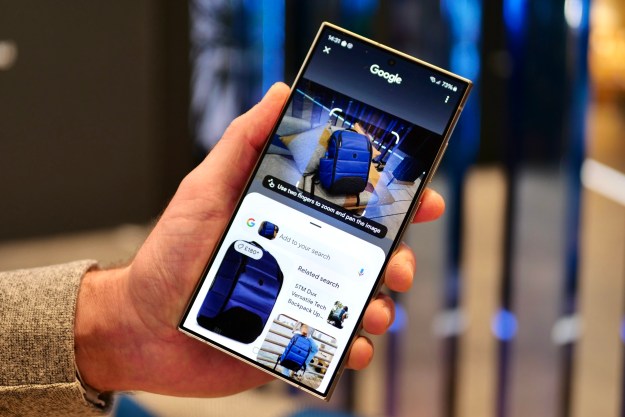There’s nothing better than setting out in search of a new phone and having lots of options. Fortunately, Mobile World Congress this year brought with it a number of awesome updates to major flagship phones, including new additions to the HTC One and Samsung Galaxy lines. The HTC One M9 packs in the latest Qualcomm Snapdragon processor, and a 20-megapixel rear camera. Meanwhile, the Samsung Galaxy S6 makes use of the newest Samsung Exynos chip and a snappy camera interface for a tight user experience. While we haven’t spent a ton of time with the phones in our hands yet, but we do already have some solid opinions on who may rule Android this year.
You can also check out our spec comparisons for [not sure what the other spec comparisons we’re running for these phones are]
|
Samsung Galaxy S6  |
HTC One M9  |
|
| Size | 143.4 x 70.5 x 6.8 mm | 144.6 x 69.7 x 9.61 mm |
| Weight | 138g | 157g |
| Screen | 5.1-inch Super AMOLED | 5.0-inch 1080p LCD |
| Resolution | 2560×1440 pixels | 1920×1080 pixels |
| OS | Android 5.0 | Android 5.0 with HTC Sense |
| Storage | 32/64/128GB | 32GB |
| SD Card Slot | No | MicroSD up to 128 GB |
| Processor | Exynos 7420 | Qualcomm Snapdragon 810 |
| RAM | 3GB | 3GB |
| Connectivity | Wi-Fi | Wi-Fi, 4G LTE, NFC, DLNA |
| Camera | Front 5MP, Rear 16MP (OIS) | Front 1080p, Rear 20MP |
| Bluetooth | Yes, version 4.1 | Yes, version 4.1 |
| Motion Processor | Accelerometer, Gyroscope, Proximity, Barometer | Accelerometer, Gyroscope, Proximity, Compass |
| Fingerprint sensor | Yes | No |
| Water Resistant | No | No |
| Battery | 2550mAh | 2840mAh |
| Charger | Wireless WPC & PMA | MicroUSB 2.0 |
| Marketplace | Google Play Store | Google Play Store |
| Ave. Price | $N/A | $N/A |
| Availability | TBD | TBD |
| DT Review | Galaxy S6 and Edge Hands-on | HTC One M9 Hands-on |
Power
The main difference between these two phones when it comes to power is the processing unit. On paper, these two processors are very similar, because each new iteration of the Exynos processor tries to come as close to its Qualcomm relative as possible. In the case of the 7420, they’ve done a remarkable job, and while the benchmarks are still a little premature, they’re pointing to 3D graphics performance getting a boost on the Exynos over the Snapdragon.
In most other aspects, however, the performance of the Snapdragon 810 beats out the Samsung-made chip, especially when it comes to RAM speed CPU integer calculations. Ultimately, this means that while most of your day-to-day operations will be snappier on the Snapdragon, 3D games will render a bit nicer on the Samsung, which also has the higher resolution display to show off these improvements.
The Galaxy S6 also has to render everything at a higher resolution (1440p), which is more taxing on its processor and battery. We honestly can’t see much of a practical difference, if any, between 1080p and 1440p on a 5-inch phone.
Winner: HTC One M9
Design
On a very basic level, the Samsung Galaxy S6 is a bit slimmer than the HTC One M9, by about 2.8mm. Whether this is a huge difference depends on how small your pockets are, since there’s very little difference when it comes to the other two dimensions of the phones.
The Galaxy S6’s screen is noticeably higher resolution than the One M9’s, with a slimmer bezel for an extra bit of screen real estate. Neither phones are water-resistant, a feature dropped by Samsung after the S5 series, possibly so they can introduce an Active version of the phone later with higher protection levels as a main feature.
When it comes to sensors, they’re both equipped with a similar set, but the Samsung adds in a fingerprint sensor for added security. While both offer a number of storage options, the HTC One M9 supports MicroSD storage up to 128 GB.
Both phones have a very classy metal look to them, but Samsung takes the cake here, with a more seamless glass and aluminum frame. HTC’s M9 has an odd cutoff now where the metal shell ends, there’s a gap, and a plastic front begins, which doesn’t look as good as last year’s M8. We also have to hand it to Samsung for creating the Galaxy S6 Edge, which doesn’t add a lot of functionality, but is a very fun looking phone with a dual curved screen.
Winner: Galaxy S6
Camera
Camera comparison is tricky when it comes to specs, because a lot of what makes or breaks a sensor is the software behind it, not the number of megapixels packed inside. It’s also tough to make a good comparison of two different smartphone cameras without spending a lot of time getting to know each of them. From our hands-on reviews, we found that the phones had different strengths when it came to taking photos.
The Samsung Galaxy S6 is designed to bring up the camera as fast as possible, claiming that whenever you hit the camera button, you’ll be ready to take a shot in less than a second. It also does a great job of tracking moving objects to keep them in focus, and the heart rate monitor on the back is used to set the white balance, with optical image stabilization built into the rear for stable shots every time.
The cameras in the HTC One M9 have a higher megapixel count than the camera in the Samsung, and it really showed when we took it for a test drive. The high quality of the photos put it in the running for one of the best smartphone cameras we’ve tried so far, with a great set of filters and double-exposure settings. It’s a lot of fun, even if it isn’t as snappy as the interface on the Samsung.
Winner: We don’t know yet
Storage
The Galaxy S6 is angering a lot of Samsung fans because it’s the first Galaxy to get rid of the removable battery and MicroSD card slot. However, Samsung offers the GS6 with 32, 64, and 128GB of onboard storage, so that does band aid some people’s storage problems. The HTC One M9 comes in 32GB, but does have a MicroSD slot.
Winner: Tie
Overall winner: Galaxy S6 (so far)
In the end, both of these phones are very similar, at least on paper. Without having spent a lot of time with either phone, it’s clear that they’re targeted at different smartphone users.
The HTC One M9 is going to perform a lot of your everyday tasks a bit faster than the Samsung, mostly due to Qualcomm’s lengthy experience with processor manufacturing. It also has the best camera if you’re looking for a phone to take lots of Instagram pics with, because of the high quality camera and built-in filters and editing.
If you want something a little flashier, the higher resolution display on the Samsung Galaxy S6 is great for gaming and media playback, and the processor will support that cause. The camera and interface are fast, but you may find that RAM-intensive operations are a bit slower than on the HTC.
Ultimately, it comes down to what you use your smartphone for, because both of these flagships run up against the newest technology, and don’t have a lot of room to beat each other out on specs.
For our money though, we’re currently leaning toward the Galaxy S6.
Are we way off? Tell us in the comments. We plan to revisit this piece throughout the year and your input is invaluable to ensure we don’t miss important distinctions.
Editors' Recommendations
- Have a Samsung Galaxy S23? Don’t update your phone to One UI 6.1
- Best Samsung Galaxy S23 Ultra deals: How to get the phone for free
- The best Android phones in 2024: the 14 best ones you can buy
- The best Samsung Galaxy S23 Ultra cases in 2024: 20 best ones
- The best Samsung Galaxy S23 Plus cases in 2024: the 17 best ones



